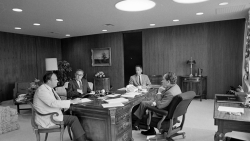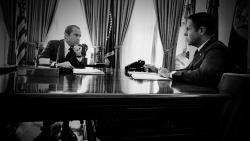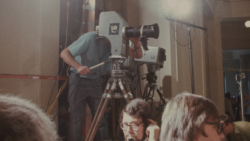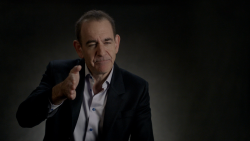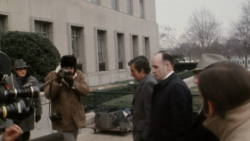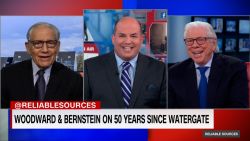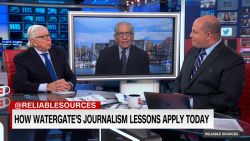Editor’s Note: Tim Naftali, a CNN presidential historian and NYU clinical associate professor, was the first federal director of the Richard Nixon Presidential Library and Museum, (2007-2011).
Story highlights
Richard Nixon's resignation as president wasn't a fait accompli
A couple of different turns in the Watergate saga likely could have spared him
When Richard Nixon announced his resignation on August 8, 1974, his favorability rating was 24% with impeachment by the House a certainty and removal by the Senate very likely. And yet just two years earlier he had won re-election in a landslide over his Democratic challenger, Senator George McGovern of South Dakota.
The ostensible reason for Nixon’s political downfall was a break-in at Democratic National Committee headquarters in the Watergate office complex on the night of June 17, 1972. The five people arrested by DC police at the scene all had connections to the Committee to Re-Elect the President. In the days that followed Richard Nixon would be the architect of a series of schemes to insulate the White House from responsibility for the bungled political espionage plot.
In the decades since Watergate, many observers have concluded that Nixon’s ultimate resignation was an example of “the system working.” However, if you look carefully at the story, Nixon very nearly got away with it.
The Watergate break in was not the first but the third time the burglars tried to enter the facility and the second time that they did. They only went in a third time to move some wiretaps that had been providing the intelligence they wanted.
There is some doubt as to whether Nixon ordered the Watergate break-in; but there is ample evidence that he conveyed to his lieutenants that he expected them to spy on his political adversaries. Indeed, in late 1971 Attorney General John Mitchell, soon to head the re-election committee, and White House Chief of Staff H. R. “Bob” Haldeman concluded that G. Gordon Liddy should be hired to lead an espionage program against the Democrats. The hiring of Liddy was the culmination of a series of dirty tricks, espionage and governmental abuses of power that made the Nixon White House the most corrupt in modern US history.
In 1969, Richard Nixon had ordered wiretaps for national security purposes that he continued long past their utility for a leak investigation because they were turning up useful political information. That same year, Nixon approved seeking federal money to renovate two new vacation homes that he purchased, ordered the Secret Service both to spy on his brother and conduct 24-hour surveillance of Senator Ted Kennedy in the hope of finding him with a girlfriend.
In 1971, Nixon approved the hiring of “thugs” from the Teamsters Union to commit acts of physical violence against anti-war demonstrators, he ordered the establishment of a special investigative unit to investigate the Pentagon Papers leak and he approved a covert action against Daniel Ellsberg in Los Angeles. That summer he also ordered that a list be compiled of all Jewish-Americans in the US government, to maintain special control over them, and sought to fire all of those in Labor Department’s Bureau of Labor Statistics. He also ordered the creation of a “tax list” later called “the enemy’s list” for harassment of his perceived political opponents by the IRS. Any one of these abuses would have been cause for impeachment. Yet all remained hidden from Congressional investigation or public view.
RELATED: Quiz: How well do you know Watergate?
It is likely that none of these crimes and abuses of power would have become public had it not been for the fact that the Nixon White House was so confident of presidential power that they reused the same criminals who worked on the Pentagon Papers case, the so-called Plumbers, for political espionage in the election year of 1972. Not only had G. Gordon Liddy been involved in the harassment of Daniel Ellsberg, but so had former CIA officer E. Howard Hunt, whose name Nixon knew and who was picked up as Liddy’s deputy for the political crimes of 1972. When the Watergate operation collapsed, it compromised both Liddy and Hunt, thus opening the possibility that good investigative journalism would reveal Nixon’s hand in White House corruption.
Most of the US media was initially not up to the challenge. Nixon was the country’s most accomplished liar, who cleverly and systematically shielded most of his bright, young staffers from the truth of his dark dealings. Only the inner core of his team – a handful of men – actually knew the reality behind the spin and they were a tough, loyal lot. As a result, with few exceptions, well-established journalists missed the deeper implications of the Watergate break-in and were content to accept the Nixon White House’s explanation of the event as an amateurish “caper” by zealots.
Two young journalists, however, who had no national reputations to lose and lots of energy, convinced their editors at the Washington Post to see where the story led. Bob Woodward and Carl Bernstein would inspire a revolution in American journalism by not accepting that the Nixon political machine was too professional and too smart to be behind a wiretapping operation at the DNC.
In 1972 it was not inevitable that a Woodward and Bernstein would keep pressing the issue. Initially they did not succeed in changing either public or political opinion about the break-in. Nixon’s cover-up held; the Court indicted only the five men arrested at the DNC and their two supervisors, E. Howard Hunt and G. Gordon Liddy. In November Nixon easily won re-election.
Had it not been for four independent developments, Nixon’s cover up might well have held:
- The sentencing judge for the Watergate burglary trial, John Sirica, sensed that perjury had been committed in his Court and decided to use his sentencing power to shake the truth out of the defendants.
- The Washington Post pieces, supplemented by some work at the Los Angeles Times and an expose on CBS News, laid the ground for a congressional investigation of campaign activities in 1972.
- Since February 1971, Richard Nixon had been taping all of his Oval Office conversations and meetings in his hideaway office at the Executive Office Building as well as many of those that he made on the telephone.
- Finally, in his confirmation hearings to replace Richard Kleindienst as US attorney general, congressional Democrats received a promise from nominee Elliot Richardson to hire an independent prosecutor to look into the Watergate affair.
Fear of long sentences would lead to a crack in the stonewalling of the burglars, thus raising concerns in the White House. Meanwhile, the congressional investigations not only turned up other evidence of abuses of government power by the White House but lead to the granting of immunity to Nixon’s ally in the cover-up John Dean who, in a dramatic monotone, would be the first member of the Nixon team to accuse the President of participation in the cover up.
But even that would not have been enough to end Richard Nixon’s political career. Polls showed that Americans were divided over whom to believe.
It was Nixon’s decision not to destroy the tapes that would seal his fate. Sick with pneumonia, Nixon was at Bethesda Naval Hospital, when his loyalists alerted him that an aide, Alexander Butterfield, was about to testify in open session about the existence of the tapes. Vice President Spiro Agnew advised the president “to build a bonfire.” Other aides, including his counsel Leonard Garment, feared that a charge of obstruction of justice, would be inevitable unless the tapes were left untouched. Nixon wavered; at one point, asking his Chief of Staff, Alexander Haig (who had replaced Haldeman in April), whether he would destroy the roughly 5,000 hours of tapes that existed. Haig said he couldn’t. But had Nixon found someone to do the job; or had he been well and in the White House, the outcome of this presidential crisis could have been very different.
Archibald Cox, the man Elliott Richardson picked as special prosecutor, would educate the American people as to the importance of the Nixon tapes and when Nixon had him fired in October 1973, talk of impeachment gripped Washington, DC, for the first time. Cox’s replacement, Leon Jaworski, continued the fight for the tapes, which resulted in a unanimous Supreme Court decision that Nixon had to turn them over.
Once members of Congress and the rest of the public read the first transcripts of the many conversations in which Nixon choreographed the cover-up after Watergate, Nixon’s impeachment and removal from office was a foregone conclusion. Unapologetic and determined to the end, a reluctant Nixon saw the writing on the wall and left office August 9. No man had fought so hard to become president; and no man fought so hard to stay president.
CNN airs “Watergate: Blueprint for a Scandal” at 9 and 10 p.m. on Sunday.

